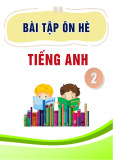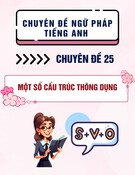HNUE JOURNAL OF SCIENCE Educational Sciences 2024, Volume 69, Issue 1, pp. 63-70 This paper is available online at http://hnuejs.edu.vn DOI: 10.18173/2354-1075.2024-0047
CULTURAL REPRESENTATION IN THE READING SECTIONS OF AN ELT TEXTBOOK: AN ANALYSIS USING CORTAZZI & JIN’S (1999) AND MORAN’S (2001) MODELS
Bui Tri Vu Nam Department of English, Ho Chi Minh City University of Education, Ho Chi Minh city, Vietnam Corresponding author: Bui Tri Vu Nam, e-mail: nambtv@hcmue.edu.vn Received May 4, 2024. Revised June 8, 2024. Accepted July 11, 2024. Abstract. This study examines cultural representation in the reading sections of an ELT textbook for 6th graders in Vietnam, employing two frameworks by Cortazzi & Jin (1999) and Moran (2001). The findings reveal that while the textbook attempts to cover a range of cultural sources and dimensions, it only skims the surface, with a predominant focus on source culture and a notable underrepresentation of target culture. Moreover, there is excessive coverage of the product dimension, which primarily features tangible elements like places, while neglecting the persons and perspectives dimensions. These findings underscore the need for more authentic content on a personal level and call for revisions to teacher resources as well as training to deepen cultural understanding. Keywords: cultural representation, ELT textbook, Cortazzi & Jin (1999), Moran (2001).
1. Introduction
Language and culture are profoundly intertwined. As Kramsch (1993) said, learning a language inevitably involves learning the culture associated with that language [1]. In Vietnam, where English is taught as a foreign language, this interconnection is prominently portrayed in textbooks, the “visible heart of any ELT programme” (Sheldon, 1988, p.237) [2]. These materials are expected to accurately introduce students to the culture of English-speaking countries through linguistic input and various activities (Ilieva, 2018) [3]. As Risager (2018) argues, textbooks serve not only as tools for language learning but also as crucial mediators of cultural knowledge and intercultural competence [4]. This dual role underscores the need for careful consideration of cultural content in EFL materials.
Recognizing the importance of culture in language education, the National Foreign Languages Project 2020, now commonly referred to as the National Foreign Languages Project (NFLP), included the ability to use English effectively in multilingual and multicultural environments as one of its key objectives. This goal was stated in the 2018 National English Language Draft Syllabus as follows: English language education should aim at “providing learners with an important means of international communication, which will enable them to explore different cultures, hence contributing to building mutual understanding among nations and developing their own capacity as global citizens” (p. 3) [5]. As part of its implementation, the NFLP initiated a comprehensive overhaul of ELT textbooks at all levels (primary, secondary, and 63
Bui TVN
high school) to fulfill these new objectives. However, a growing body of research has identified cultural representation issues in the new textbook series. For example, an evaluation of high school textbooks by Nguyen and Cao (2019) showed that although the books made an effort to “globalise their cultural contents”, they do not allow students to critically interact with the materials for “deep-level intercultural learning”, and they portray a static perspective of culture, which can lead to “generalizations and stereotypical assumptions”. [6]. Further research by Nguyen et al. (2019) revealed the limitations of locally produced high school English textbooks from an English as an International Language (EIL) perspective, which suggest that the books predominantly focus on interactions with Anglophone speakers despite their aim to prepare students for international communication [7]. A more recent study by Kieu (2021) examined the pilot high school English textbooks under the NFLP, showing that general cultural knowledge was extensively covered while specific cultural insights were lacking [8].
As can be seen above, most studies have primarily focused on the high school level, while few have addressed the secondary level. This oversight is significant because at 11 years old, children are transitioning from the concrete operational to the formal operational stages of cognitive development, as described by Piaget [9]. They begin to think more abstractly and critically, making this an ideal time to introduce and discuss diverse cultural perspectives and practices. Moreover, at the secondary level, students spend four years, which is a longer period than in high school. Neglecting cultural aspects in language classes at this level could be a missed opportunity, if not detrimental to their future learning. Therefore, this research paper aims to partly address this gap by examining the cultural representation in the reading sections of the Global Success textbook for 6th graders [10], [11]. This series was selected because it is completely locally written, unlike the other series that are either semi-adopted or fully adopted from international content. This allows for a more accurate evaluation, as the analysis is not constrained by limitations that come with adapted materials. The full local authorship ensures that any cultural representation choices are intentional and reflective of the authors' complete creative control, providing a clearer picture of how cultural content is conceived and presented in Vietnamese ELT materials.
Specifically, this study seeks to answer the following questions: 1. To what extent are the sources of cultures (source, target, international, and culture- neutral) presented in the reading sections of Global Success Tiếng Anh 6? 2. To what extent are the dimensions of cultures (products, practices, perspectives, communities, and persons) presented in the reading sections of Global Success Tiếng Anh 6?
2. Content
2.1. Research methodology
To address the research questions, this study uses the textbook analysis method by Tomlinson (2012), which includes material analysis and material evaluation [12]. Given the scope of this study, the focus will be primarily on material analysis, as accurate evaluation can only be conducted following thorough analysis. Material analysis involves the systematic examination of educational content using specific frameworks to generate detailed descriptions of the material. For this purpose, two cultural frameworks have been selected: Cortazzi & Jin’s (1999) framework [13] and Moran’s (2001) model [14]. 2.1.1. Cortazzi & Jin’s (1999) framework
According to Cortazzi and Jin (1999), culture is “the framework of assumptions, ideas, and beliefs that are used to interpret other people’s actions, words, and patterns of thinking” (p. 197) [13]. This definition illustrates culture as a complex web of interpretive frameworks that people 64
Cultural representation in the reading sections of an ELT textbook: An analysis using…
use to communicate both locally and interculturally, which is relevant to the current status of English as a lingua franca. In line with this definition, Cortazzi and Jin categorized cultural content in educational materials into three types in terms of origin:
Source Culture: Content from the learner's own culture. Target Culture: Content from the culture where the language is natively spoken.
International Culture: Content from other cultures besides source and target cultures. Since communicating interculturally involves navigating numerous variables, such as differing social norms, values, and communication styles, this framework emphasizes the breadth of cultural experiences, ensuring that learners are exposed to a wide spectrum of cultural viewpoints and are equipped to manage diverse combinations of cultural variables in various contexts. 2.1.2. Moran’s (2001) model
In his work, Moran (2001) elaborated on a multidimensional approach to understanding culture within the educational realm [14]. This model is particularly effective at bridging the gap between language learning and cultural insight. Specifically, Moran divided culture into five dimensions:
Products: Tangible and intangible creations of a culture such as literature, music, tools, technology, laws, and social structures.
Practices: Behaviors, rituals, and social customs prevalent within a culture. Perspectives: Values, attitudes, and beliefs that underpin cultural practices and products.
Communities: Groups of people who share common cultural practices. Persons: Individuals or types of characters that embody or represent cultural narratives or values.
Compared to Cortazzi and Jin’s, Moran's framework goes deeper into the nuances of culture in teaching materials. It promotes a more immersive and comprehensive cultural learning experience, which is crucial for fostering genuine intercultural competence. 2.1.3. Rationale for using both frameworks
Cortazzi and Jin’s framework is utilized to address the first research question, which focuses on identifying the origins of cultural content within the textbook. Meanwhile, Moran’s framework is used to answer the second research question, which examines the depth of cultural dimensions covered in the textbook. Both frameworks are used to maximize the analytical depth and breadth. This also ensures a balanced view of where and how cultural elements are integrated, providing a holistic view of cultural representation.
2.2. Research data
This study calls for a data-driven approach. Data were collected directly from the two volumes of the Global Success textbook for 6th graders, focusing specifically on the reading section of each unit. The reading parts from the review sections were excluded due to their focus on language review rather than new cultural content, making them less relevant for the analysis. Below is a table that systematically organizes the content of the reading sections from the books: Table 1. Overview of Reading Sections in Global Success Tiếng Anh 6
Unit Title Reading genre Content description
1 My New School Descriptive Essay
Descriptions of three different schools: Sunrise, a boarding school in Sydney; An Son, a local school in Bac Giang; Dream, an international school.
65
Bui TVN
My House 2 Personal Narrative Discussion on a stay at the Crazy House Hotel in Da Lat, focusing on its unique architecture and themed rooms.
My Friends 3 Advertisement & Email The detailed activities are available at Superb Summer Camp and include a personal email about a child's experiences there.
Blog Post 4 My Neighbourhood A blog about the suburbs of Da Nang, describing the local environment, amenities, and community life.
5 Informational Text Natural Wonders of Vietnam Highlights of natural attractions in Vietnam such as Ha Long Bay and Mui Ne, discussing their scenic beauty and tourist activities.
6 Our Tet Holiday Informational Text Description of how New Year's is celebrated in different cultures, focusing on the USA, China, and Vietnam.
Television TV Guide 7 A list of different TV programs and their descriptions, ranging from wildlife to sports and science.
Interview 8 Sports and Games An interview about Pelé’s life, his football career, and his influence as a global sports icon.
Postcard 9 Cities of the World A postcard from Stockholm detailing a visit to the Royal Palace and local Swedish customs like “fika.”
Predictive Text 10 Our Houses in the Future Imagination of futuristic living scenarios on an island with advanced technology and robotics.
interview discussing Interview 11 Our Greener World An various environmental practices at school, such as recycling and reusing resources.
12 Robots Informational Text Details of an international robot show in Hanoi, describing various robots and their applications in everyday life and beyond.
2.3. Findings and discussion
2.3.1. Answer to research question 1: Analysis based on Cortazzi and Jin’s framework
At first glance, the textbook appears to include all types of cultural sources, with source culture being predominant and target culture being the least emphasized. This is evident in the titles of the units, which use possessive pronouns such as “my” and “our” in the first six units. The authors seem to have intended to start at the local level and progress to more international, culture-neutral topics, such as cities around the world and technology. This strategy likely stems from an understanding that English is now an international language. However, this lack of target culture may hinder students’ understanding of English-speaking cultures, which are crucial for
66
Cultural representation in the reading sections of an ELT textbook: An analysis using…
the comprehension of the language’s contextual nuances, as Politzer pointed out: “If we teach language without teaching at the same time the culture in which it operates, we are teaching meaningless symbols or symbols to which the student attaches the wrong meaning” [15;100-101]. In terms of source and international cultures, it seems their inclusion was somewhat weak due to the basic treatment of cultural content, which complicated the classification process. For example, in Unit 1, schools from different cultural settings are merely mentioned by name and location without delving into their specific educational practices or local contexts. This makes it challenging to categorize these mentions definitively within the source culture and international culture categories. Similarly, in Unit 3, the reading attempts to create an international context in Vietnam by including both Vietnamese and international students on a camping trip. However, this effort stops short at describing the international student with an Anglo appearance (blonde hair and blue eyes) and a positive personality. While this scenario could arguably be classified as international culture, this simplistic cultural setup may result in a tokenistic presentation of cultural diversity, reducing it to a background element rather than leveraging it as a substantial educational tool. Such tokenistic representation can potentially reinforce stereotypes and give students a misleading impression of cultural diversity.
The issue of authenticity also emerges as a major obstacle, particularly for the classification of the source culture content. In fact, although source culture representations are theoretically the most numerous, many of them cannot be definitively identified as such due to the lack of authenticity. For instance, Unit 7 features a TV guide with a segment on Cuc Phuong Forest followed by several possibly fictitious shows, pushing this content towards being classified as culture-neutral. This pattern is recurrent throughout the textbook; simply mentioning names without deeper engagement does not effectively convey cultural nuances. As shown in the table below, weak refers to cases where the origin is mentioned at a very basic level that could be considered culture-neutral. Table 2. Sources of Cultures in the Reading Sections of Global Success Tiếng Anh 6
Unit Cultural origin Examples from textbook
target,
Unit 1: My New School Sunrise, a boarding school in Sydney; An Son, a local school in Bac Giang; Dream, an international school source, international (all weak)
Unit 2: My House source the Crazy House Hotel in Da Lat
Unit 3: My Friends source, international (weak) a camping event at Ba Vi mountains with both Vietnamese and international friends
4: My source a blog about the suburbs of Da Nang Unit Neighbourhood
Natural source Ha Long Bay and Mui Ne 5: Unit Wonders of Vietnam
target, 6: Our Tet Unit Holiday how New Year's is celebrated in USA, China, and Vietnam source, international (all weak)
Unit 7: Television source (weak) Cuc Phuong Forest and invented TV shows
international (weak) Unit 8: Sports and Games an interview about Pelé’s life, his football career, and his influence as a global sports icon
67
Bui TVN
international (weak) a postcard from Stockholm Unit 9: Cities of the World
culture-neutral a future house with futuristic technologies Unit 10: Our Houses in the Future
interview discussing various Unit 11: Our Greener World an environmental practices at school source, international (both weak)
Unit 12: Robots an international robot show in Hanoi source, international (both weak)
2.3.2. Answer to research question 2: Analysis based on Moran’s model
The analysis shows significant gaps in the cultural content. The products dimension, which includes places and artifacts, is the most prominently featured while practices and communities receive just below moderate coverage. In terms of quantity, the dimensions of persons and perspectives are the least represented.
As to depth of coverage, the cultural engagement remains mostly basic to nonexistent. Although a few units are classified as having moderate depth, most of them fall within the products dimension. Notably, the content often focuses on tangible elements like places and artifacts, while richer cultural aspects, such as real social customs and personal stories of real people, are largely neglected. Additionally, the inclusion of fictitious content further diminishes the depth of cultural understanding. This suggests a need for more authentic content to enhance the depth of coverage. Admittedly, Moran did not provide extensive guidelines on how to measure the depth of each dimension within his framework. However, the coverage depth emerged as an unexpected outcome of applying both Cortazzi, Jin's and Moran's models in succession. Initially, Cortazzi and Jin's model was employed to examine the breadth of cultural representation, but its application prompted considerations of depth as well, as evidenced by the weak evaluation in the previous section. This insight was then further explored and refined when using Moran's model.
The analysis based on Moran’s model has confirmed a general lack of depth in the cultural content, as previously suggested by the findings from Cortazzi and Jin’s framework. This reinforces the notion that breadth and depth are intricately linked at multiple levels. The limited depth observed could likely be attributed to the textbook’s target audience (sixth graders), whose linguistic proficiency is still developing. As a result, the language input must be easy to understand, and consequently, the cultural content is inevitably simplified to match their comprehension levels. Table 3. Dimensions of Cultures in the Reading Sections of Global Success Tiếng Anh 6
Unit Cultural dimension Specific aspects Depth of coverage
Unit 1: My New School products, practices institutions, acts basic
Unit 2: My House products artifacts, places moderate
Unit 3: My Friends communities coexisting basic
4: My communities places moderate Unit Neighbourhood
Natural products places moderate Unit 5: Wonders of Vietnam
68
Cultural representation in the reading sections of an ELT textbook: An analysis using…
Unit 6: Our Tet Holiday acts, social customs basic practices, perspectives
products artifacts basic Unit 7: Television
persons individuals moderate Unit 8: Sports and Games
products, practices places, scenarios moderate Unit 9: Cities of the World
artifacts, perceptions basic Unit 10: Our Houses in the Future products, perspectives
coexisting basic Unit 11: Our Greener World communities, practices
Unit 12: Robots products artifacts basic
3. Conclusions
Overall, the reading sections of Global Success Tiếng Anh 6 tend to overemphasize source culture and the product dimension in terms of quantity, while underrepresenting target culture and the dimensions of persons and perspectives. This results in an imbalanced representation. Additionally, much of the content is presented at a surface level, which limits its potential for deeper cultural engagement. These findings align with those observed in textbooks at the high school level [6]-[8], suggesting that these drawbacks might be consistent throughout the entire series.
To address these gaps, the researcher suggests several approaches. First, the authors could add more personal, real-life stories from both target and source cultures. This can significantly increase the depth of cultural engagement. Second, cultural notes or quizzes could be added to the teacher’s book as extra materials. These resources can enhance teachers’ cultural awareness as well as give them the flexibility to choose relevant content for their classes. This also minimizes the need for extensively revising the book, thereby avoiding the risk of complicating the content. Finally, teacher training sessions should be provided to show how to effectively use these materials in classrooms.
It is important to acknowledge that this study is limited in scope, as it only examined the reading sections of the textbook. Future research should expand the scope to include the other parts such as listening exercises, speaking activities, and writing tasks, in order to produce a more comprehensive evaluation.
REFERENCES
[1] Kramsch C, (1993). Context and culture in language teaching. Oxford University Press. [2] Sheldon LE, (1988). Evaluating ELT textbooks and materials. ELT Journal, 42(4), 237-246. DOI: 10.1093/elt/42.4.237.
[3] Ilieva R, (2018). Textbooks. The TESOL Encyclopedia of English Language Teaching, 1-
13. DOI: 10.1002/9781118784235.eelt0666.
[4] Risager K, (2018). Representations of the World in Language Textbooks. Multilingual
Matters, p. 264.
[5] MOET, (2018). National English Language Draft. Ministry of Education of Vietnam, Hanoi
(in Vietnamese).
69
Bui TVN
[6] Nguyen TTM & Cao THP, (2019). An evaluation of the intercultural orientation of secondary English textbooks in Vietnam. In: Van GT, Nguyen HM, Nguyen TTM & Minh TH (eds.), Building teacher capacity in English language teaching in Vietnam (1st ed.), p. 16. Routledge.
[7] Nguyen TTM, Marlina R & Cao THP, (2020). How well do ELT textbooks prepare students to use English in global contexts? An evaluation of the Vietnamese English textbooks from an English as an international language (EIL) perspective. Asian Englishes, DOI: 10.1080/13488678.2020.1717794.
[8] Kieu TH, (2021). An investigation into intercultural components in three piloted English textbooks for Vietnamese high schools under the National Foreign Languages Project. VNU Journal of Foreign Studies, 37(1), 29. DOI: 10.25073/2525-2445/vnufs.4655.
psychology J, of intelligence (1st ed.). Routledge.
[9] Piaget
(1950). The https://doi.org/10.4324/9780203164730.
[10] Hoang VV, Nguyen TC, Le KD, Phan CN, Vu MT & Luong QT, (2023). Global Success
English 6 (Vol 1). Vietnam Education Publishing House.
[11] Hoang VV, Nguyen TC, Le KD, Phan CN, Vu MT & Luong QT, (2023). Global Success
English 6 (Vol 2). Vietnam Education Publishing House.
[12] Tomlinson B, (2012). Materials development for language learning and teaching. Language
Teaching, 45(2), 143-179. DOI: 10.1017/s0261444811000528.
[13] Cortazzi M & Jin LX, (1999). Cultural mirrors: Materials and methods in the EFL classroom. In: Hinkel E (eds.), Culture in second language teaching and learning,p. 196-219. Cambridge University Press.
[14] Moran RT, (2001). Teaching culture: Perspectives in practice. Heinle & Heinle. [15] Politzer R, (1959). Developing Cultural Understanding Through Foreign Language Study. In: Mueller HJ, (1954), Report of the Fifth Annual Round Table Meeting on Linguistics and Language Teaching, p. 99-105. Georgetown University Press.
70

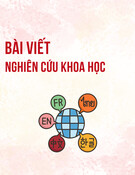
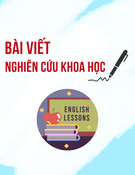

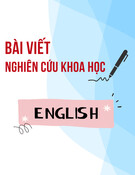
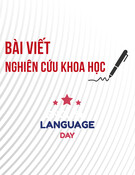
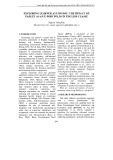
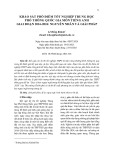
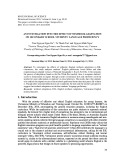
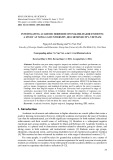

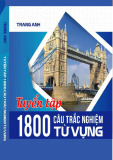
![Tài liệu Từ vựng tiếng Anh Trung cấp [mới nhất]](https://cdn.tailieu.vn/images/document/thumbnail/2025/20250913/nguyentuan250421@gmail.com/135x160/99491757910839.jpg)
![Tài liệu Từ vựng Tiếng Anh theo chủ đề [mới nhất]](https://cdn.tailieu.vn/images/document/thumbnail/2025/20250913/namdhuet@gmail.com/135x160/83251757753810.jpg)
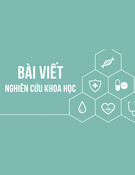
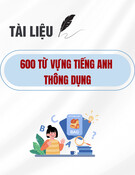
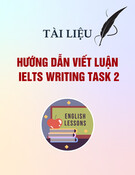
![Tài liệu Từ vựng tiếng Anh cho bé [chuẩn nhất/mới nhất]](https://cdn.tailieu.vn/images/document/thumbnail/2025/20250731/huadaithesang2509@gmail.com/135x160/18631754013896.jpg)





